2008.03.12 11:39
The Discreet HARM of The Bourgeoisie...
...acquinted with the little icons BIG uses to brand each of their designs. In further curating at Quondam, I today happened to past through Morphosis Exhibit Redux again, and was immediately "shocked" by how the image shapes now remind me of BIG icons. A whole new set of building designs began flashing through my imagination.
2008.05.16 10:38
Now try taking it to court.
When it comes to making "a diagram or a plan that shows the ideas of a building, I like to think at least big.
2011.05.21 10:49
SMALL, BIG, FOG and LEONG LEONG
What we have 'now' (as you've provided evidence to above) is that Mountain Dwellings by BIG and Beekman Tower by FOG and Audi Urban Future by Leong Leong all have a past, a history if you will, that extends back beyond their own existence. Whether wittingly or not, the BIG, FOG and Leong Leong designs all relate (genealogy) back to respective Glen Small designs. (Just as John Stezaker's more recent collage work has a past that relates to some of my collage work from over 25 years ago.)
Conversely, what we also have 'now' (as you've provided evidence to above) is that Turf Town and Copy Cat Skyscrapers and Jungle Theater all have a future beyond their own existence. In this case completely unwittingly, the Glen Small designs all relate (is progeny the converse of genealogy?) forward to respective BIG, FOG and Leong Leong designs. (Just as some of my collage work from over 25 years ago relates forward to John Stezaker's more recent collage work.)
[Coincidentally, the movie I saw last night, The Double Hour, very much plays with the intermingling of a shared past and future, and, in the movie's case at least, the chaos that may well then ensue.]
It is quite common for designs to have a past that extends back beyond their own existence. And, conversely, it is more rare for designs to have a future that extends forward beyond their own existence. I'm not sure how much attention current architectural history pays explicitly to designs that have a future beyond themselves.
What's the best art 20 years from now? OR What's Glen Small designing these days?
[Does seeking precedents... ...finding inspiration play with the intermingling of a shared past and future?]
| |
2013.05.22 11:28
What are the cultural ingredients of architecture today?
$ is a perrenial ingredient of architecture. Is China building so much because now they have lots of money? Yes. Does Dubai exist because of lots of money? Yes.
Just did a google search koolhaas yes culture.
"Junkspace pretends to unite, but it actually splinters. It creates communities not of shared interest or free association, but of identical statistics and unavoidable demographics, an opportunistic weave of vested interests. … Its financing is a deliberate haze, clouding opaque deals, dubious tax breaks, unusual incentives, exemptions, tenuous legalities, transferred air rights, joined properties, special zoning districts, public-private complicities. Funded by bonds, lottery, subsidy, charity, grant: an erratic flow of yen, euros, and dollars (¥?$)."
and
Let me ask you about your quote about the need to "accept the world in all it's sloppiness and somehow make that into a culture." Does this still reflect your current thinking?
Rem Koolhaas: Well, yes and no. Of course, behind every project we do there is a kind of vast critical apparatus of doing better. We're not trying to emulate the current mess. We are just as interested in the sublime. Actually, that is why I'm talking about the other buildings we are doing, because they are really exceptionally ambitious in terms of not emulating confusion or something, but ambitious as architectural works in and of themselves.
on architecture and capitalism . . .
Rem Koolhaas: I think what Mies tried to do is find a way to make the sublime compatible with capitalism . . . extract from capitalism the kind of elements that are sublime. . . . I think that the first real engagement with the aesthetics of capitalism is a kind of transcending it.
I think that after that, perhaps (Robert) Venturi and (Denise) Scott Brown were the second wave of looking at capitalism, perhaps with a greater sense of realism. The presence of capitalism and the results of capitalism were much more blatantly present, making it clear that you could almost not transcend it anymore, and you needed to find some accommodation with its aesthetics.
And I think that if you place Mies in the late 40's or early 50's, and if you place the beginning of the Venturi's thing in the late 60's or early 70's, then 20 years later of course globalization and the market euphoria become even more unfettered, and that is why I had to begin to look, with the Harvard project, at shopping, because I think that at that point almost all architectural production had contracted and focused on this one program, which in itself had morphed in such a way that it now included everything, all components. So for me, it was very important to address that, and also to see whether those demands had actually fundamentally changed the kind of spaces that we produce and the spaces that we need.
So you could say that the Venturi's are in the middle in terms of having a kind of positive relationship with the iconography of capitalism. Mies in a way stood above it, and Junkspace was a more internal look, when the positive attitude of the Venturi's was no longer tenable and where we had to admit and realize it was actually a much more ominous development. So, in a way, Junkspace is a theory, and what for me is very important about this building (the IIT Student Center) is that it tried to really work not so much within the same vocabulary but see what an architect could still do within that syndrome or within that regime.
You're so good at defining the reality of the world - the good things and the horrible things - that sometimes when I read your writings, it's very hard for me to see what you actually think about the things you're describing.
Rem Koolhaas: There are so many opinions in architecture. I think in the beginning it was just kind of exciting to describe and not to give so many opinions. If you read them (Koolhaas's writings), you also feel that you are in the presence of a very critical mind, or at least I hope so. Certainly in the case of Junkspace I think that should be overwhelming. But at the same time, I don't want to simplify things and say I'm against them when they have a degree of inevitability, but I would say our buildings are more and more able to really disconnect from those realities, or try to make the best out of them.
Is Bjarke "Yes is More" Ingels architecture's leading hipster?
Is "Design like you don't give a damn" implicit?
In perspective then: a monster[ous] grand tour[ism of] the real taboo domain.
Is Network Culture ever going to be a book?
"Look Bullwinkle, a message in a bottle!"
"Fan-mail from some flounder?"
Scripting. 3D printing. Ride the wave into the future?
"Architects inherently want to make the world a better place."
I attended a Denise Scott Brown lecture back in the (early-mid) 90s. She used the word 'boring" several times, as in, "Here's another boring plan." During the Q&A I wanted to ask, "So, are you trying to tell us that a bore is more?"
| |
2013.11.20 18:41
20 November
Danish architecture firm BIG has won a competition to design a new Museum of the Human Body in Montpellier, France:
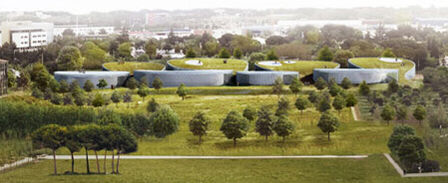
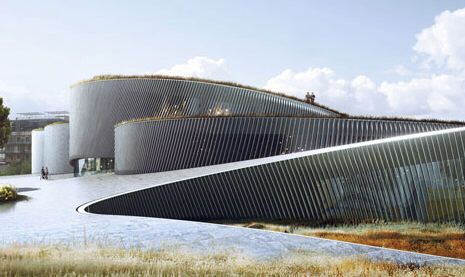
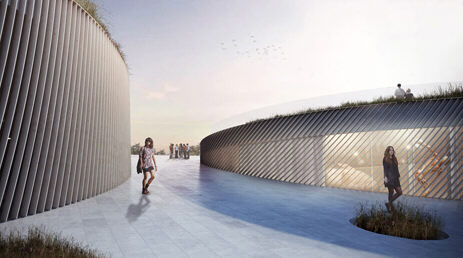
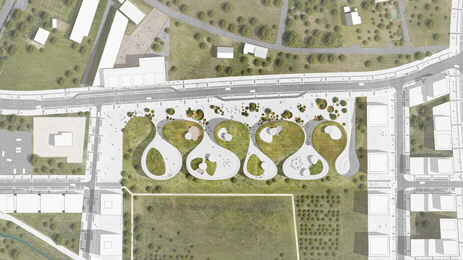
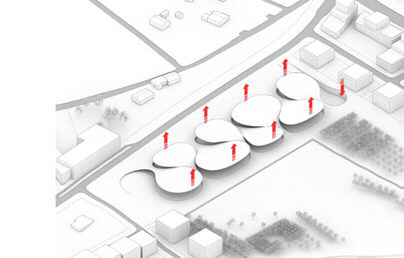
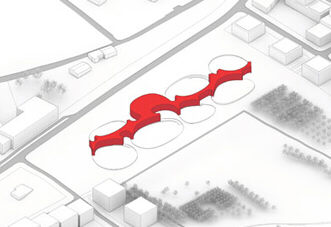
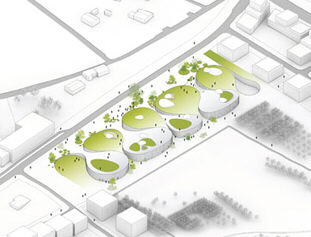
Images of the Museum of the Human Body design quickly brought to mind these images from (mostly) over ten years ago:
|